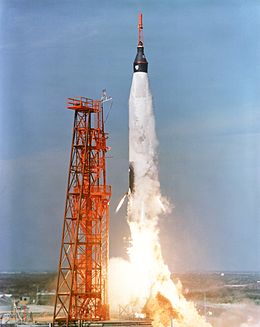Mercury-Atlas 5

An Atlas rocket launches the Mercury-Atlas 5 into orbit, November 29, 1961
|
|
| Mission type | Test flight |
|---|---|
| Operator | NASA |
| Harvard designation | 1961 Alpha Iota 1 |
| SATCAT no. | 208 |
| Mission duration | 3 hours, 20 minutes, 59 seconds |
| Distance travelled | 81,902 kilometers (50,892 mi) |
| Orbits completed | 2 |
| Spacecraft properties | |
| Spacecraft | Mercury No.9 |
| Manufacturer | McDonnell Aircraft |
| Launch mass | 1,331 kilograms (2,934 lb) |
| Start of mission | |
| Launch date | November 29, 1961, 15:07:57 UTC |
| Rocket | Atlas LV-3B 93-D |
| Launch site | Cape Canaveral LC-14 |
| End of mission | |
| Landing date | November 29, 1961, 18:28:56 UTC |
| Orbital parameters | |
| Reference system | Geocentric |
| Regime | Low Earth |
| Perigee | 158 kilometers (85 nmi) |
| Apogee | 237 kilometers (128 nmi) |
| Inclination | 32.5 degrees |
| Period | 88.44 min |
| Epoch | November 29, 1961 |
|
Project Mercury
Mercury-Atlas series |
|
Mercury-Atlas 5 was an American unmanned spaceflight of the Mercury program. It was launched on November 29, 1961 with Enos, a chimpanzee, aboard. The craft orbited the Earth twice and splashed down about 200 miles (320 km) south of Bermuda.
By November 1961, the Soviet Union had launched Yuri Gagarin and Gherman Titov into orbit during the Vostok 1 and Vostok 2 manned orbital flights while the United States had managed only suborbital ones. At that time NASA was still debating placing a chimpanzee in orbit as part of the Mercury-Atlas subprogram, with NASA headquarters questioning the wisdom of the Manned Spacecraft Center launching another unmanned Mercury mission.
The NASA Public Affairs Office issued a press release stating "The men in charge of Project Mercury have insisted on orbiting the chimpanzee as a necessary preliminary checkout of the entire Mercury program before risking a human astronaut." prior to the flight.
The flight used Mercury capsule #9 and Atlas #93-D. On February 24, 1961 spacecraft # 9 arrived at Cape Canaveral. It took 40 weeks of preflight preparation. This was the longest preparation time in the Mercury program. The mission of spacecraft # 9 kept changing. It was first configured for a suborbital instrumented flight, then for a suborbital chimpanzee flight, then a three-orbit instrumented mission, and finally for the orbital flight that Enos flew.
...
Wikipedia

